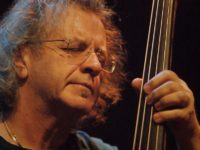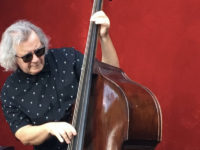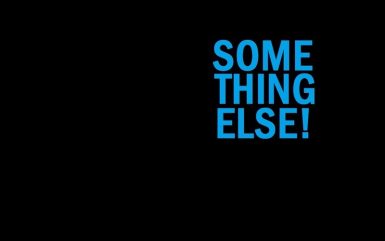Since the 1950s, adventurous jazz artists have held experiments that fuse jazz with classical music, commonly referred to as ‘Third Stream.’ Renowned jazz bassist Michael Bisio — who is also well versed in classical music — undertakes his own endeavor into this high-brow hybrid with NuMBq (February 14 2025, Mahakala Music), where he unveils his new quartet that’s like no other.
Any notion that this genre has been exhausted are quickly dispelled by Bisio and his NuMBq ensemble, primarily because this quartet doesn’t follow conventions for neither jazz nor classical. Joining Bisio and his bass are violist Melanie Dyer and English hornist Marianne Osiel, with Jay Rosen on drums. The unique talents arrayed are matched to unique composing canniness of Bisio, pulling together elements of the formal with the informal, an alchemy that produces sounds that challenges the very established forms it’s derived from.
“Elegy For MG” is classical and improvised music, but sequentially so. Following an ad-hoc drum intro is a delicately conceived piece involving the intertwining of English horn, viola and bowed bass. But the sparks start to fly when Bisio takes command, leading the quartet into collective unrestraint while staying within key and circling back to a doleful emotion.
“Broken Waltz” swings in the deep jazz tradition but the English horn with viola substituting for, say, a saxophone and a trombone, shifts the harmonic space and sounding more structured while actually playing largely free. Bisio’s bass anchor gives Osiel and Dyer permission to take those chances.
Classical music hues within the architecture of advanced modern jazz makes “Medicaid Melancholy” an imaginative hybridization. “Going Home Amazing Grace” is seven minutes of Bisio and Dyer listening to, responding to and directing each other as they create a tuneful harmony together.
The chamber music elements are countered by what Bisio terms “fire music,” the free-flowing jazz that enables purer expression and allows each musician to reveal their true musical character. Tracks like “improv 1091” and “AC 2.0nu” demonstrate the group dynamic in this way. For the latter, Bisio’s cantankerous arco bass and Rosen’s drums set up the framework around which everyone else creates on the fly.
“Vib Gyor” likewise springs from group improv but is more episodic, as is “Densities Roy G Biv,” probably due to the fact that Bisio used graphic scores for these compositions. In each performance, the instinctual confluence of the bass, viola and English horn sounds a little exotic but entirely euphonic.
Much of Michael Bisio’s body of work has exhibited big ambition within small settings. The four musicians of NuMBq led by Bisio puts a bit of a classical orchestra into their quartet of unbound adventurers.
*** Michael Bisio CD’s and vinyl on Amazon ***
- James Brandon Lewis Quartet – ‘Abstraction Is Deliverance’ (2025) - May 27, 2025
- Soft Machine – ‘Drop’ (1971, 2025 remaster) - May 21, 2025
- Marshall Allen’s Ghost Horizons – ‘Live In Philadelphia’ (2025) - May 19, 2025




